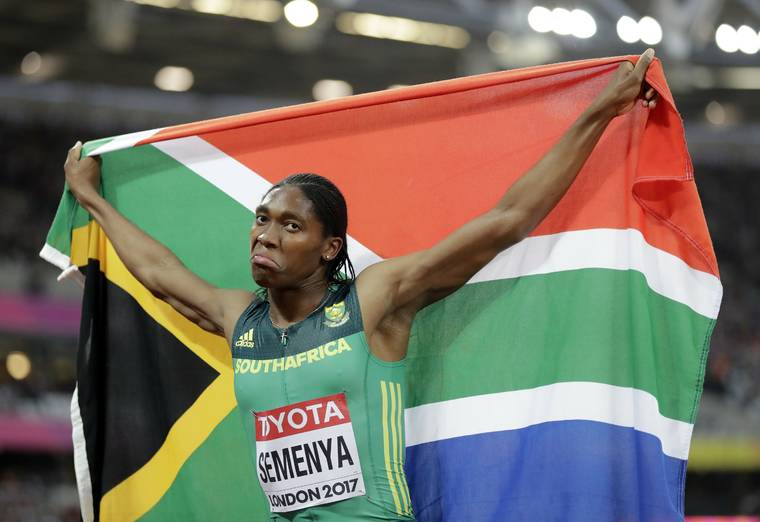GENEVA — The sports world’s highest court ruled Wednesday that Olympic champion Caster Semenya and other female runners like her with unusually high testosterone must take medication to reduce their levels of the male sex hormone if they want to compete in certain events.
In a landmark 2-1 decision , the Court of Arbitration for Sport upheld proposed rules issued by track’s governing body, the IAAF, saying that they are discriminatory but that “such discrimination is a necessary, reasonable and proportionate means” of “preserving the integrity of female athletics.”
The IAAF argued that unusually high, naturally occurring levels of testosterone in athletes like Semenya with “intersex” characteristics that don’t conform to standard definitions of male and female give them an unfair competitive advantage, and it decreed a maximum level for females.
The 28-year-old South African runner whose sculpted biceps and super-fast, blow-away-the-competition times have led others to question her accomplishments declared she will not be stopped by the ruling.
“I know that the IAAF’s regulations have always targeted me specifically,” Semenya said in a statement. “For a decade the IAAF has tried to slow me down, but this has actually made me stronger. The decision of the CAS will not hold me back. I will once again rise above and continue to inspire young women and athletes in South Africa and around the world.”
The two-time Olympic champion in the 800 meters will have to lower her testosterone levels if she wants to defend her world title in September in Doha, Qatar.
Semenya was traveling to Doha on Wednesday for the first Diamond League track meet of the season, where she is expected to race in the 800 on Friday. The Diamond League is an annual series of meets for the top athletes in the world, and the event is the last one before the new rules apply.
Testosterone strengthens muscle tone and bone mass. Because of that, it is against the rules for athletes to inject or swallow testosterone supplements. Some women have what is known as hyperandrogenism, meaning they have naturally occurring levels that are unusually high.
The IAAF rules require women to reduce their levels below 5 nanomoles per liter of blood. According to the IAAF, most females, including elite athletes, have levels of testosterone circulating naturally in their bodies of 0.12 to 1.79 nanomoles per liter, while men have levels that can be dozens or even hundreds of times higher — typically 7.7 to 29.4.
Semenya’s level is considered private medical information and has not been disclosed.
The South African Sports Confederation and Olympic Committee decried the ruling, saying, “We maintain that the rules are ill-thought and will be a source of distress for the targeted female athletes.”
“This decision marks a massive turning point as it now redefines what a female athlete in particular is,” said Natalie du Toit, head of the organization’s athletes commission, adding: “Knowing Caster and the hard work she has put into her sport, we support all her endeavors, and we are all behind her.”
The IAAF went into the case arguing that female runners with high testosterone have an unfair advantage in events from 400 meters to the mile. However, the court suggested that the IAAF apply the rules only up to the 800 because the evidence was not clear that women with hyperandrogenism have an edge in the 1,500 meters.
That could give Semenya a route to compete at the world championships without taking medication, such as birth control pills.
A further appeal is possible to Switzerland’s Supreme Court in Lausanne. But judges rarely overturn decisions of the world sports court.
Ross Tucker, a sports science consultant who testified on Semenya’s behalf and boasts of a Ph.D. in exercise physiology, said the scientific evidence that the fairness of women’s athletics is being compromised is insufficient to justify the rule.
“Is the evidence strong enough and good enough to back the policy? I don’t see good science having been followed here,” he said.
Semenya was legally recognized at birth as female, but her speed and muscular body have led others to cast doubt on the integrity of her track achievements throughout her career. As a teenager in 2009, she won her first world title in Berlin. Hours before the race, the IAAF had asked for Semenya to undergo a gender verification test.
Semenya’s case was the second effort by the IAAF to regulate such athletes. In 2015, a panel including two of the same judges who heard Semenya’s case blocked the IAAF’s first attempt in an appeal brought by Indian sprinter Dutee Chand.
The judges four years ago said the IAAF did not prove hyperandrogenic women gained a significant advantage, and invited the organization to submit new evidence. The IAAF produced a fresh scientific study.
Semenya is not the only female athlete with high natural levels of testosterone but has become an unwilling face of the issue. Two weeks ago, Olympic silver medalist Francine Niyonsaba of Burundi confirmed she has the same hyperandrogenism as her rival in the 800.
Referring to the rule, Niyonsaba said: “For me, it’s about discrimination. It doesn’t make sense. I didn’t choose to be born like this. What am I? I’m created by God.”
At the 2016 Rio Olympics, Semenya and Chand were publicly identified as women with high testosterone, but other athletes implied that other runners, including medalists in the 800 meters, also had elevated levels.
“I think that we need separate events for them and for us,” said Nataliia Lupu of Ukraine said after running against Semenya. “You can see that it’s easy for them.” Semenya will “definitely win against us, even without using her full strength.”
———
AP Sports Writer Gerald Imray in Somerset West, South Africa, contributed to this report.
———
More AP sports: https://apnews.com/apf-sports and https://twitter.com/AP—Sports



